Abstract
Indonesia made general election reformation in 1998. The fund campaign rules had been enacted since then. Indonesia rules on fund campaign include the obligation to disclose to source of fund campaign. Based on the data collected and published publicly, it enhances the transparency and comparability. Accurate information about fund campaign is rarely available to the public. Corruption related to fund campaign poses a threat to development of democracy in the world. It is revealed that personal risk of bankruptcy may happen to certain candidates. The reasons are they need to raise money for campaign to be elected. The source of the campaign fund majority comes from personal funding. National Democratic Institute for Indonesia Affairs had research on political fund campaign in 22 countries in 2005. It divided into African countries and non African countries. Fund campaign source in Indonesia based on the public financial report on General Election Commission (KPU) website. The research goal is to see whether any differences between fund campaign source proportions in Indonesia compare to the world, non African and African countries. It is analyzing by chi square (non parametric). It could be concluded that Indonesia fund campaign source proportions are different with the world, non Africa and Africa countries. The difference may come from the personal candidate funding that is around 40%-50% in the world, while in Indonesia is 85%. The result and research could be more explore to see the relationship between proportions of fund campaign funding to the corruption.
Keywords: Proportion of fund campaigngeneral electionIndonesia election
Introduction
Fair election campaign is a goal for any nations. It will lead to true democratic. Many interests are involved and influenced. Political parties become the role in this area because democratic cannot function without political parties. Their mission is preparing and choosing candidates for parliamentary and presidential elections and supporting as leadership. To be chosen is a long way to go. Trust, campaign, characters, race, religion, and any others, will be main articles to be selected and appointed. It needs all the collaborations among the candidates, political parties, supportive group and public.
A young politician from Barisan Nasional party in Malaysia felt down. He was an appointed candidate for a state assembly seat. He expected that all component parties would campaign for him. It turned down. He asked advised for understanding situation to the elder. It is found out that he had to make contributions for others to help and to pay the expenses. It would cost around RM 10,000 to RM 20,000 per branch
Problem of fund raising are causing anxiety to the politicians and to all who care about democracy. Political parties need to generate fund for electoral campaign and operational cost as institution. Candidates need to pay political campaign, such as travelling expenditures, rallies and events, media campaign, lobbies, and others.
In some countries, the cost for campaign is so expensive. One leader in Kenya told that 90 percent funding come from personal source. It turns to be digging deep of the saving, properties and loan. If not being elected then it will severe for a long time. Candidate could end up bankrupt and sell everything to cover the loan
There are fund campaign regulation to limit the interest beyond the democracy, but the development of regulation across the nations are varies. To be abreast in democracy has been time consuming, involving many years, and many mistakes. Britain took 27-256 years, France took 78-168 years, Germany took 30-80 years, USA took 30-70 years and Japan took 50 years
The regulations to disclose of campaign funds have been adopted by nations such as USA, Thailand, and Indonesia. Disclosing the source of donation for campaign fund would enhance transparency. In the future would reduce payback from contributors in some ways.
It is not easy for candidate to raise fund from public, business, and organizations. In USA, raising fund is something common and people will voluntarily support and give donation based on their preferences. Today, USA stands up after a long experience in democracy. They got the big scandal on donation in 1996 called Asian Connection. There was an attack toward President Clinton and the Democratic National Committee (DNC) from the rival. The issue addressed John Huang who raised money from illegal foreign Asian sources, James Riady, owner of Lippo Group Indonesia. The donation was $4.5 million out of total of $2.2 billion in federal election. It was small percentage amount (0.2%). They were accused of putting the presidency and public policy in danger for accepting money from foreigners. The investigation failed to produce any evidence to support the allegation but gained success to divert public attention for fund campaign reform. John Huang told that his motive was to help empower and to represent the interest of Asian Americans. Many disregard this opinion and have strong beliefs that they represented the interest of the transnational political and economic elite and profit, market penetration and also political influence
Donation could be tools for rival to weaken the position of the candidate. Public, business, political parties, foreign sources become careful due to the transparency and potential bad addressee opinion on them. If they want to support then usually contributions would normally be given in cash, so that it would not be traced back to contributors. The money would be given directly to the candidate and not through the account. If there is no donation especially for unpopular candidate then the burden of fund campaign is on candidates.
While the burden is on candidate, the money politics could be quite stand for the legitimate period of the positions. It may turn to lead on corruption to pay back of the campaign fund expense. It may that the elected candidate would not be able to deliver the promises because lack of funding or they may look for short cut by helping transactional position as long as giving advantage to the chosen candidate.
Indonesia made general election reformation in 1998. The fund campaign rules had been enacted since then. Indonesia rules on fund campaign include the obligation to disclose to source of fund campaign. In ASEAN countries, there is no obligation to disclose the donation except in Thailand. It is quite common in many countries. Accurate information about fund campaign is rarely available to the public. Based on the data collected and published publicly, it enhances the transparency and comparability. It is important because there is concern that fund campaign style could lead to fraud, especially corruption. Not many scholars reveal this issue because the difficulty of the data but from the campaign source we might find some facts to be learned to be good democratic nation.
The research wants to explore the fund campaign source among countries in the world. It is quite interesting to address whether Indonesia fund campaign source has the same pattern with other countries that are the same stage or beyond democratic path as Indonesia.
Problem Statement
Fund campaign is the key challenges for future democracy. Candidate would seek donation to supporting campaign by any means. This is the downside because would lead to corruption, illegal practices, and democracy crisis. Some donors give fund for their business while others may not need it apparently in this time. In the future, they would have to payback while needed. Fund campaign is high. Candidate chosen who want to look pay back for the campaign fund may do unethical conduct in money politics. If the salary is not covering enough, fraud probably will occur. The risk is high.
Fraud
According to Webster’s Dictionary, fraud is intentional deception to cause a person to give up property or some lawful right or a person who deceives or is not what he pretends to be (Neufeldt & Guralnik, 1996). Another cited of fraud is an act of deliberate action or mistake made by person or group of person who knows that the error can result in some benefits that are not either to individuals or entities or other parties (Ernst & Young, 2009).
Types of fraud are (ACFE’s Report to the Nations 2016):
Corruption
Corruption is the second frequency among other types of fraud. In 2012 is 33.4%. In 2014 is 36.8%, and in 2016 is 35.4%.
Conflicts of interest
Bribery
Illegal Gratuities
Economic Extortion
Asset Misappropriation
This takes the biggest frequency among other types of fraud. In 2012 is 86.7%. In 2014 is 85.4%, and in 2016 is 83.5%.
Cash
Inventory and All Other Assets
Financial Statement Fraud
This fraud is last frequency among other types of fraud. In 2012 is 7.6%. In 2014 is 9.0%, and in 2016 is 9.6%.
Net Worth/Net Income Overstatements
Net Worth/Net Income Understatements
Fraud Triangle Theory
Donald Cressey is known as father founding of fraud triangle theory. It started in 1950 he was criminologist who interviewed 250 criminals in 5 months to find reasons people to violate trust. He took two criteria: (i) the person must have accepted a position of trust in good faith, and (ii) the person must have violated the trust. He found that three factors must be present for a person to violate trust and was able to conclude that:
Problem or pressure: trust violators, when they conceive of themselves as having financial problem which is non shareable, and have knowledge or awareness that this problem can be secretly resolved by violation of the position of financial trust. Perceived pressure can result from various circumstances. Financial pressure is the most common type of pressure (Abdullahi, Mansor, & Nuhu, 2015; Albrecht, Albrecht, & Albrecht, 2008). The other pressure is non-financial that may come from personal issues in inner dissatisfaction, greed, lifesyte and company isseues such as fear to lose job, and low wage (Mackevicius & Giriunas, 2013).
Opportunity: the fraudster sees a way to use their position of trust to solve the financial problem, knowing they are unlikely to be caught. Opportunity is created by ineffective control of governance system that allows an individual to commit organizational fraud (Abdullahi, Mansor , & Nuhu, 2015). Employees and managers who have been around for years know the weaknesses are in the internal controls and have gained sufficient knowledge of how to commit the crime successfully without fear and stress (Ewa & Udoayang, 2012).
Rationalization: the fraudsters are first time offenders with no criminal record. They see themselves as ordinary, honest people who are caught in a bad situation (Cressey, 1953).
The tree elements of fraud are presented in a diagram shown in figure
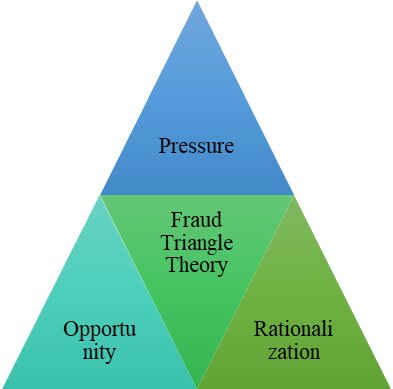
Fraud Diamond Theory
The fraud triangle theory transforms to be fraud diamond theory by adding a fourth element. In Addition to pressure, opportunity and rationalization, also consider individual capability (see figure
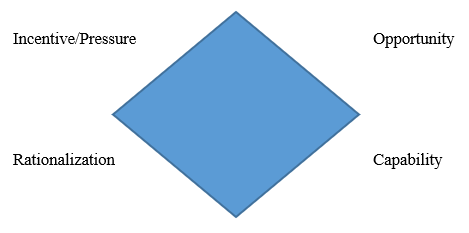
There are several essential traits for committing fraud:
The person’s position or function within the organization may furnish the ability to create of exploit an opportunity for fraud not available to others. It may result commiting to fraud increases as the knowledge of the funcion’s processes and controls expands over time.
The right person for a fraud is smart enough to understand and exploit internal control weaknesses and to use position, function, or authorized access to the greatest advantage.
The right person has a strong ego and great confidence that he will not be detected, or the person believes that he could easily talk himself out of trouble if caught.
A successful fraudster can coerce others to commit or conceal fraud. A person with a very persuasive personality may be able to convince others to go along with a fraud or to simply look the other way.
A successful fraudster lies effectively and consistently. The other character is keep track of lies consistently so that the story is convicting.
A successful fraudster deals very well with stress. Commiting a fraud and managing the fraud over a long period of time can be extremely stressful. There is the risk of detection, with its perrsonal ramifications, as well as the constants need to conceal the fraud on a daily basis.
The summary of component of capability is on figure
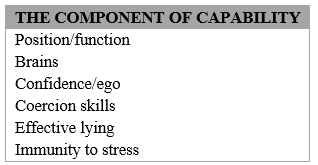
Corruption
Corruption is part of fraud. According to Webster’s dictionary, definition of corruption is a dishonest or illegal behavior especially by powerful people (such as government officials or police officers)
The Corruption Perceptions Index (CPI) measures the perceived levels of public sector corruption worldwide. The scale score is 0 (highly corrupt) to 100 (very clean). Over 176 countries are valued and none is 100. The highest score is 90 for Denmark and New Zealand. There are 120 countries have score below 50. The average score is 43. Indonesia is on 90 rank with 37 score. In Asia Pacific, the highest score is New Zealand (90) and the bottom is North Korea (12)
Global Fraud Survey is conducted in 2015 with the respondents are have involved occupational fraud across the nations. The total loss in this case exceeded $6.3 billion with an average loss per case of $2.7 million. The median loss is $150.000. Asset misappropriation is the most common form of occupational fraud. Corruption fell in the middle with 35.4% of cases and a median loss of $200.000
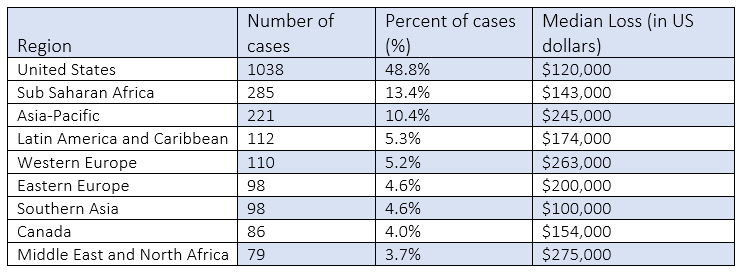
In Asia Pacific region, the highest scheme type is corruption with 107 cases (48.4%). The highest type of victim organization is private company (37.7%), followed by public company (26.8%), government (18.7%), not for profit (10.1%) and other (5%). In case of government, the federal government is the highest impact in term of median loss
ACFE Indonesian Chapter conducts the same survey as ACFE Global in 2016. The survey coverage is Indonesia. The most fraud case in Indonesia is corruption (67%), followed by asset misappropriation (31%) and last is fraud in financial reporting (2%). The modus of corruption is around Rp100 millions to Rp500 millions. Fraud is detected mostly by report (37%) from the employee 47.5%). The perpetrators are dominated by men (97%) and women (3%). The most impact victim organization is government (81.2%), the second one is state company (8.1%) and the third is private company (7.2%), followed by others (2.2%) and not for profit organization is 1.3%
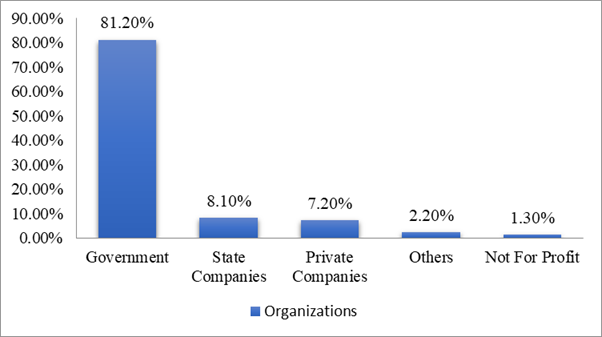
The Corruption Eradication Commission (KPK)
KPK is independent organization with mission is to combat corruption in Indonesia. The vision is making Indonesia free from corruption. In 2016, KPK conducted survey to identify potential conflict of interest of candidates for heads of regions related to local election contributions. The result showed that the actual expenses in local election were greater than the wealth reported (LHKPN). Candidate spent for campaign more than their cash (51.4%) and more than the total assets (16.1%). They were done off balance sheet by not put all expenses in the Report of Receipt and Expenditure of Campaign Fund (LPPDK), and the Report of Contribution for Campaign Fund (LPSDK)
There is potential conflict arose when expense more than cash or asset. The candidates would ask donation to narrow the gap. In the future, the donators may ask for help to pay back the help. The candidate was aware about potential conflict in the future (56.3%). Not all donations were reported in LPSDK, only 64% reported
The compensation for helping the candidates comes in many forms. It could be the handling for obtaining licences (65.7%), gaining position in the government (60.1%), getting portion in the procurement of government goods/services (64.7%), securing business (61.5%), accessing formulation of policy or local regulations (49.3%) and receiving assistance for charitable activities/grant (51.7%)
According to the type of case, bribery was the highest rank with 79 cases. The second rank was crimes in the procurement of goods/services with 14 cases and the last was money laundering with 3 cases. More than 497.6 billion rupiah were paid to the state treasury from the corruption cases
Corruption cases by agency are divided into ministries (39 cases), house of representatives (15 cases), province or local house of representatives (11 cases), provincial government (13 cases) and district/city governments (21 cases).
The result of KPK cases by position of perpetrators reveals that there were 26 cases implicating private persons. There were 23 cases implicating members of house of representative. Only 10 cases of corruption were involving officials and 8 cases involving regents/mayors and vice regents/mayors
Indonesia Problem Statement
The pattern of fraud in the world is different with Indonesia in term of the form. The first place of fraud in the world is asset misappropriation while in Indonesia is corruption (ACFE, 2016, Indonesia ACFE, 2017). Based on the fraud triangle theory that financial pressure, opportunity and rationalization could lead to fraud, the candidate who spends fund campaign more than his ability has the financial pressure, where appointed could have opportunity for doing fraud and positively having realization to paying back the fund
Indonesia is 90 ranks on the CPI Index in Asia Pacific region. The average score of Asia Pacific region is 44, the same average score for American countries. The highest region is EU and Western Europe with average score is 66. Below that is Middle East and North Africa (38), Eastern Europe and Central Asia (34), and Sub-Sahara Africa (31)
In Indonesia, government is the most impact victim organization
Based on the rationalization that house of representative pressure comes from the financial stress on fund campaign and the position CPI of Indonesia compare to others, we will look the proportion of fund campaign source between Indonesia, the world, non Africa and Africa countries.
Research Questions
Based on proportion of fund campaign in Indonesia, we would like to investigate:
Is there any difference proportion of fund campaign source between Indonesia and the world?
Is there any difference proportion of fund campaign source between Indonesia and Non Africa countries?
Is there any difference proportion of fund campaign source between Indonesia and Africa countries?
Purpose of the Study
The purpose of the study was to investigate whether there is any difference proportion of fund campaign between Indonesia, the world, Non Africa countries, and Africa countries.
Research Methods
Non parametric test is used. Chi Square implemented to see whether there is different proportion among them.
The proposed hypothesizes are:
Ho1 = There is no difference proportion of fund campaign source between Indonesia and the world
Ha1 = There is differences proportion of fund campaign source between Indonesia and the world
The second hypothesis is looking between Indonesia and Non Africa countries:
Ho2 = There is no difference proportion of fund campaign source between Indonesia and Non Africa countries
Ha2 = There is difference proportion of fund campaign source between Indonesia and Non Africa countries
The third hypothesis is looking between Indonesia and Africa countries:
Ho3 = There is no difference proportion of fund campaign source between Indonesia and Africa countries
Ha3 = There is difference proportion of fund campaign source between Indonesia and Africa countries
Data
The data were secondary. National Democratic Institute for International Affairs (NIDA) examined party finance practices in 22 emerging democracies worldwide. The data collected not only depend on published data and statistics but also interview individuals directly involved in party financing because the data available of the fund campaign source and expenses are hard to get. The countries are divided into Africa, Europe, Asia, and Latin America that can be seen on figure
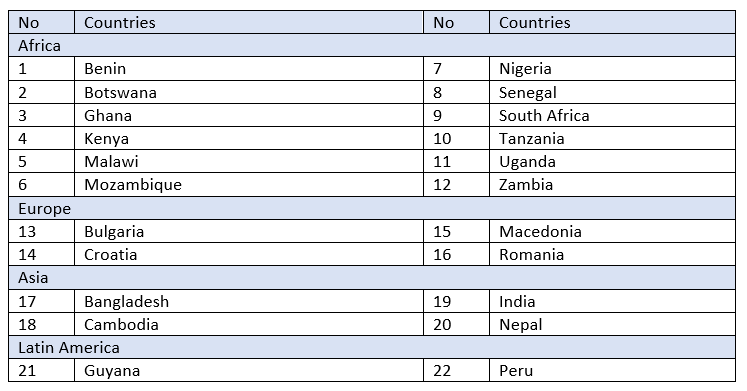
Fund campaign source of Indonesia is taken from the fund campaign reporting by political parties on house of representative general election in Indonesia in 2014. The report was submitted to General Election Commission (KPU) and put on Indonesia General Election Commission website (KPU, 2014). Every political party had to submit fund campaign report. The data is summarized using descriptive statistic. It is on figure
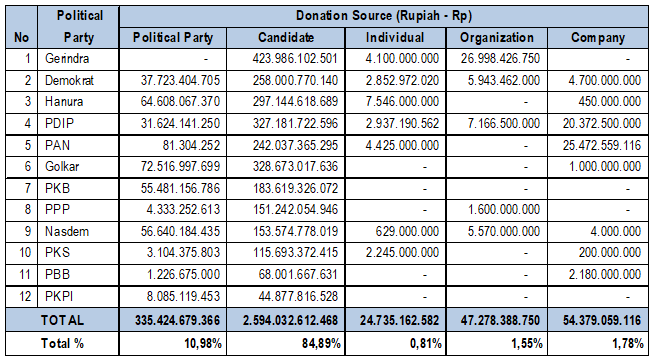
The proportion fund campaign source in Indonesia then comparing with NIDA in 22 countries as shown on figure

Findings
Result Hypothesis 1: Indonesia versus The World
The result of running chi square test on hypothesis 1 is rejected Ho1 and accepted Ha1. The critical value with α= 5% is 9.488 when counted value is 43.36. The counted value 43.36 is higher than 9.488 is Ha1 is accepted. There is differences proportion of fund campaign source between Indonesia and the world. The result is shown on figure
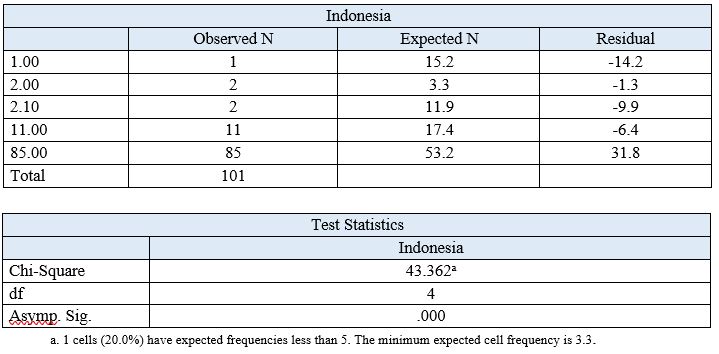
The differences between Indonesia and the world may because Indonesia just being real open democratic in 1998, while others have stood since so long ago. The average score CPI for the world is 43. Indonesia is 37
Result Hypothesis 2: Indonesia vs Non Africa Nations
The result of running chi square test on hypothesis 2 is rejected Ho2 and accepted Ha2. The critical value with α= 5% is 9.488 when counted value is 70.742. The counted value 70.742 is higher than 9.488 is Ha2 is accepted. There is differences proportion of fund campaign source between Indonesia and non Africa nations. The result is shown on figure
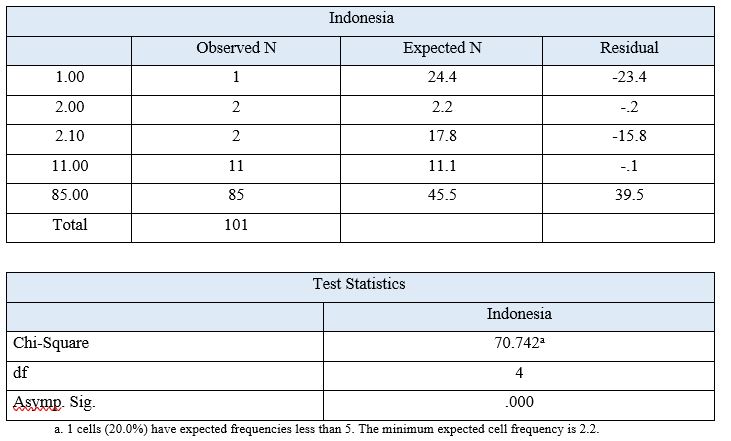
The non-Africa nations are Croatia (49), Rumania (48), Bulgaria (41), India (40), Macedonia (37). They have the same and higher CPI score compare to Indonesia. On the other side Peru (35), Guyana (34), Bangladesh (26), and Cambodia (21) are lower than Indonesia
Result Hypothesis
The result of running chi square test on hypothesis 3 is rejected Ho3 and accepted Ha3. The critical value with α= 5% is 9.488 when counted value is 35.432. The counted value 35.432 is higher than 9.488 is Ha3 is accepted. There is differences proportion of fund campaign source between Indonesia and Africa nations. The result is shown on figure
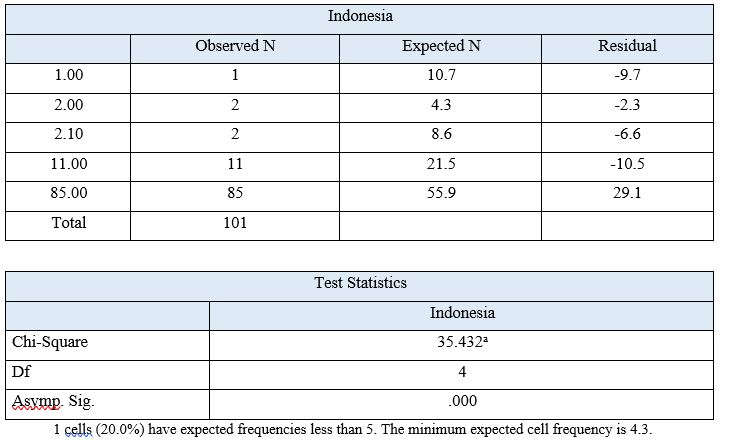
On the average Africa nations have CPI score of 31 that is lower than Indonesia (37)
Conclusion
There is consistent concern that fund campaign burden is the beginning of a cycle that eventually leads to corruption and undermines the successful democratic. Based on fraud triangle theory stated fraud could happen because of three components: pressure, opportunity, and rationalization. The fraud diamond theory completed adding one component: capability. The financial burden of fund campaign on candidate was the real financial pressure. The rationalization for doing fraud was the need to pay back and feel all candidates would do the same, using the legitimate power for doing fraud when the opportunity came. The capability belonged to chosen candidate from the position, brain, and confidence. In Indonesia the highest fraud form is corruption. According to CPI Index, Indonesia is rank on 90 with score of 37. The house of representative involved in 23 corruption cases in Indonesia on 2016. Government is the highest impact victim on corruption in Indonesia. The proportion of fund campaign source Indonesia is different with the proportion of fund campaign source in the world, non-Africa nations, and Africa nations. The most implied difference comes from candidate fund in Indonesia reached 85%. It is so different with the world that only has burden on candidate for 49%, when non-Africa nations is 41% and Africa nations are 52%. It is reflected on the corruption perception index that Indonesia is in the middle. Non-Africa nations have higher score while Africa nations have lower score compare to Indonesia. As stated before that this issue needs to be fixed either by regulation or expenses capped on fund campaign so that candidate would not ended bankrupt or being corrupt after chosen. The true transparent democratic would be achieved.
Acknowledgments
The authors would like to express their appreciation for the support of the Ministry of Research, Technology and Higher Education of the Republic of Indonesia on competitive research grants scheme.
References
- Abdullahi, R., Mansor , N., & Nuhu, M. S. (2015). Fraud Triangle Theory and Fraud Diamond Theory: Understanding the Convergent and Divergent for Future Research. European Journal of Business and Management, 7(28), 30-37.
- ACFE. (2016). Report to The Nations on Occupational Fraud and Abuse. Austin, Texas: ACFE Association of Certified Fraud Examiners.
- Albrecht, W. S., Albrecht, C., & Albrecht, C. C. (2008). Current Trends in Fraud and its Detection: A Global Perspective. Information Security Journal, 17(1), 2-12.
- Bryan, S., & Baer, D. (2005). Money in Politics: A Study of Party Financing Practices in 22 Countries. Washington DC: National Democratic Insitute for International Affairs.
- Cressey, D. R. (1953). Other People's Money. Montclair, NJ: Patterson Smith.
- Ernst, & Young. (2009). www.ey.com. Retrieved August 2, 2014, from Ernst & Young: www.ey.com/Publication/vwLUAssets/FIDSFI Detecting Financial Statement Fraud.pdf/$FILE/FIDS-FI_detectingFinanceFraud.pdf
- Ewa, E. U., & Udoayang, O. J. (2012). The Impact of Internal Control Design on Banks' Ability to Investigate Staff Fraud, and Life Style and Fraud Detection. Nigeria International Journal of Research in Economics & Social Sciences, 2(2), 32-44.
- Indonesia ACFE, C. (2017). Survai Fraud Indonesia 2016. Jakarta, Indonesia: ACFE Indonesia Chapter.
- Intenational, T. (2017, January). Corruption Perceptions Index 2016. Retrieved November 15, 2017, from Transparency International: www.tranparency.org
- Jong, R. (2014, September 18). Malaysia Today. Retrieved November 5, 2017, from Malaysia Today: https://www.malaysia-today.net/the-big-money-behind-political-power
- KPK. (2017). KPK Annual Report 2016. Jakarta, Indonesia: The Corruption Eradication Commission (KPK).
- KPU, T. (2014, Maret 20). Dana Kampanye. Retrieved September 17, 2017, from Komisi Pemilihan Umum Republik Indonesia: http://kpu.go.id/index.php/pages/detail/2017/267/Dana-Kampanye/NzE0
- Kusumasari, L. (2017, September). The Impact of Campaign Fund Training in Indonesia. Advanced Science Letters, 23(9), 8069-8074.
- Mackevicius, J., & Giriunas, L. (2013). Transformational Research of the Fraud Triangle. Ekonomika, 92(4), 150-163.
- Nassmacher, K.-H. (2003). Introduction: Political Parties, Funding and Democracy. In R. Austin, & M. Tjernstrom, Funding of Political Parties and Election Campaigns (p. 1). Stockholm: International Institute for Democracy and Electoral Assistance.
- Neufeldt, V., & Guralnik, D. B. (1996). Webster's New World College Dictionary. New York: Macmillan USA.
- Wang, L. L.-c. (1998, January). Beyond Identity and Racial Politics: Asian Americans and the Campaign Fund-raising Controversy. Asian American Law Journal, 5, 329-340.
- Wells, J. T. (2005). Principles of fraud examination. Hoboken, NJ: John Wiley & Sons Inc.
- Wolfe, D. T., & Hermanson, D. R. (2004, December). The Fraud Diamond: Considering the Four Elements of Fraud. The CPA Journal, 38-42.
Copyright information

This work is licensed under a Creative Commons Attribution-NonCommercial-NoDerivatives 4.0 International License.
About this article
Publication Date
01 May 2018
Article Doi
eBook ISBN
978-1-80296-039-6
Publisher
Future Academy
Volume
40
Print ISBN (optional)
-
Edition Number
1st Edition
Pages
1-1231
Subjects
Business, innovation, sustainability, environment, green business, environmental issues
Cite this article as:
Kusumasari, L., & Wardhani, S. L. (2018). The Proportion Of Indonesian Fund Campaign Compares To Other Countries. In M. Imran Qureshi (Ed.), Technology & Society: A Multidisciplinary Pathway for Sustainable Development, vol 40. European Proceedings of Social and Behavioural Sciences (pp. 1073-1087). Future Academy. https://doi.org/10.15405/epsbs.2018.05.85

